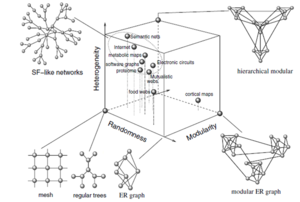Robustness of complex networks (project)
From Santa Fe Institute Events Wiki

Problem statement
Complex networks have various properties which can be measured in real networks (WWW, social networks, biological networks), e.g. degree distribution, modularity, hierarchy, assortativity etc. Robustness of complex networks is a big question, however only some progress have been done in this direction. For example, it was shown that the scale-free networks are much more topologically robust to random attacks than random networks. Many people claim that various characteristics of complex networks will influence the robustness interdependently. The question I am interested in is how?
Approach
The idea is to generate continuous topology space of various complex networks (networks with different modularity, degree distribution, hierarchy etc) and use it to measure their robustness (see Fig. 1). There are many approaches to measure the robustness of complex networks. For example we can remove edges of vertices of a complex network graph and look at the size of a giant cluster. We can discuss other possibilities.
If you are interested you can contact me directly or via my E-mail: krystoferivanov@gmail.com or via my discussion page in CSSS 2012 wiki.
Relevant literature
- Important papers about network generation are highlighted in bold
- BA Scale-free network
- How to generate Scale-free modular network using preferential attachment
- Scale-free networks with tunable degree distribution exponents
- Scale free networks with tunable clustering
- Error and attack tollerance of complex networks
- Structural Robustness of Complex networks
- Assortative mixing in networks
- Mean field theory to study scale-free networks
- Kroneker Graphs
- Exact maximum-likelihood method to detect patterns in real networks
- Biological robustness
- Attack vulnerability of complex networks
- Supply Network Topology and Robustness against Disruptions – an investigation using multi agent model
- Random graphs with arbitrary degree distributions and their applications
- Resolution limit in community detection - about a typical modularity measure and its limitations
- Add a relevant paper...
Learning Python
Participants
- Oleksandr Ivanov - krystoferivanov@gmail.com
- Ian Wood - ibwood@indiana.edu
- Xin Lu - xin.lu@ki.se
- Duenas-Esterling Marco-Antonio - maduenase@gmail.com
Source Control
I've set up a github repository for any python source we write here. To figure out how to use Git look here. Chapters 1,2,3, and 5 are particularly relevant, but I can run through the basics with anyone. It's useful to have a source control for both project coordination and backup, and git is very simple once you get the hang of it.
There is a shared folder on skype, please either sign your email in the participant list or drop a email to Xin Lu to access the generated network data. Dropbox link [1]
BA algorithm in Python
BA network + modularity
- Networkx source
- Caution! when you copy this to the Python delete one space from the first line, i.e., before def
def powerlaw_cluster_graph(n, m, p, seed=None): """Holme and Kim algorithm for growing graphs with powerlaw degree distribution and approximate average clustering.
Parameters ---------- n : int the number of nodes m : int the number of random edges to add for each new node p : float, Probability of adding a triangle after adding a random edge seed : int, optional Seed for random number generator (default=None).
Notes ----- The average clustering has a hard time getting above a certain cutoff that depends on m. This cutoff is often quite low. Note that the transitivity (fraction of triangles to possible triangles) seems to go down with network size.
It is essentially the Barabási-Albert (B-A) growth model with an extra step that each random edge is followed by a chance of making an edge to one of its neighbors too (and thus a triangle).
This algorithm improves on B-A in the sense that it enables a higher average clustering to be attained if desired.
It seems possible to have a disconnected graph with this algorithm since the initial m nodes may not be all linked to a new node on the first iteration like the B-A model.
References ---------- .. [1] P. Holme and B. J. Kim, "Growing scale-free networks with tunable clustering", Phys. Rev. E, 65, 026107, 2002. """
if m < 1 or n < m: raise nx.NetworkXError(\ "NetworkXError must have m>1 and m<n, m=%d,n=%d"%(m,n))
if p > 1 or p < 0: raise nx.NetworkXError(\ "NetworkXError p must be in [0,1], p=%f"%(p)) if seed is not None: random.seed(seed)
G=empty_graph(m) # add m initial nodes (m0 in barabasi-speak) G.name="Powerlaw-Cluster Graph" repeated_nodes=G.nodes() # list of existing nodes to sample from # with nodes repeated once for each adjacent edge source=m # next node is m while source<n: # Now add the other n-1 nodes possible_targets = _random_subset(repeated_nodes,m) # do one preferential attachment for new node target=possible_targets.pop() G.add_edge(source,target) repeated_nodes.append(target) # add one node to list for each new link count=1 while count<m: # add m-1 more new links if random.random()<p: # clustering step: add triangle neighborhood=[nbr for nbr in G.neighbors(target) \ if not G.has_edge(source,nbr) \ and not nbr==source] if neighborhood: # if there is a neighbor without a link nbr=random.choice(neighborhood) G.add_edge(source,nbr) # add triangle repeated_nodes.append(nbr) count=count+1 continue # go to top of while loop # else do preferential attachment step if above fails target=possible_targets.pop() G.add_edge(source,target) repeated_nodes.append(target) count=count+1
repeated_nodes.extend([source]*m) # add source node to list m times source += 1 return G
